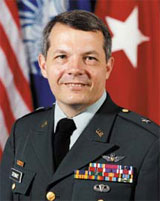| Q&A with UTA's oldest living graduate | Alumni as college presidents | Recognition of contributors |
 |
||
| Home Forethought Campus Buzz Feature Stories Re:Search The Score Alum News Yesteryear | ||
Retired Brig. Gen. Robert Stewart loves to fly. He’s at home in the cockpit of 38 types of airplanes and helicopters—as well as the space shuttle.

After starting his career as a helicopter pilot, the UTA Distinguished Alumnus and former Army aviator eventually logged approximately 6,000 hours flight time. During his two space shuttle missions (aboard the Challenger in 1984 and the Atlantis in 1985), he discovered that the terms “up” and “down” have no real meaning in space.
As Stewart explains, about six minutes into a shuttle flight, the crew begins to notice a faint silver glow along the top of the windshield. The glow continues to brighten until, all at once, Earth comes into view. But it’s not “below” the shuttle; instead, it is—or seems to be—above the spacecraft, out the top windows.
“Earth is in the local up direction because we go into orbit upside down for some reason lost in mathematical niceties, or maybe it’s just arcane tradition,” says Stewart, who graduated from UTA in 1971 with a master’s degree in aerospace engineering.
The view, even upside down, is remarkable.
“Your first view of the home planet is breathtaking. Maybe that’s how God intended it to be viewed. You see the lovely azure of the Atlantic overlaid by the pristine white of swirling clouds, and here comes the green of Africa, the whole floating in a velvety black universe.”
Once the astronauts become accustomed to the stunning sights, their thoughts turn next to speed.
“Your second impression is, ‘Boy, are we going fast.’ We’re used to thinking in terms of air travel. In an airliner you travel at 500 miles per hour, 40,000 feet above the ground, and it hardly seems like you’re moving. But at speeds approaching 17,000 miles per hour, friends, you know you are smoking along. The visual impact of seeing thunderstorms gliding by like cotton balls is stunning.”
Even though astronauts are exhaustively trained, highly educated and technically expert, Stewart says that somewhere within every aviator is a kid who just loves to fly. In the weightless atmosphere of space, sometimes that kid has to come out. Once the mission is under way, crewmembers alternate work with periods of what Stewart calls the “sheer joy of looking out the window at the lovely planet we call home.” And every activity takes place without the constricting aspects of gravity, an environment of complete freedom of movement.
“You want to have lunch on the ceiling, by all means do so,” he says. “Attack a swarm of free-floating peanuts on the mid-deck like Jaws himself, but be careful—they might not all be peanuts. And if you are very lucky, don a space suit and go outside. The colors come alive, and the visible detail is far beyond that which can be brought back on film or tape. It is truly an experience that borders on indescribable.”
In 1986, while training for his third shuttle mission, the Army selected then-Col. Stewart for promotion to brigadier general. He was reassigned from NASA to be deputy commanding general, U.S. Army Strategic Defense Command in Huntsville, Ala. In 1989 he moved again, this time to Colorado, where he served as the director of plans, U.S. Space Command, Colorado Springs. Stewart, 62, and his family liked the area so much that when he retired, in 1992, he stayed on in the mountain West.
Today he continues to do occasional consulting in the aerospace industry and is a speaker with the Prayer Breakfast Network, frequently addressing large community gatherings. He also keeps an eye on what’s happening in the world of space travel and agrees with the president’s decision to end the shuttle program.
“Maybe this will encourage the development of better technology,” he says. “I would like to see us go back into space, too, but the shuttle is a dangerous machine.” And although for many years space shuttle missions became almost “routine” to outside observers, he says, “believe me, nothing has ever been routine on the space shuttle.”
— Sherry W. Neaves
| Archives
| Alumni Association |
Giving to UTA | UTA
Home Copyright © 2005 UTA Magazine. All rights reserved. |